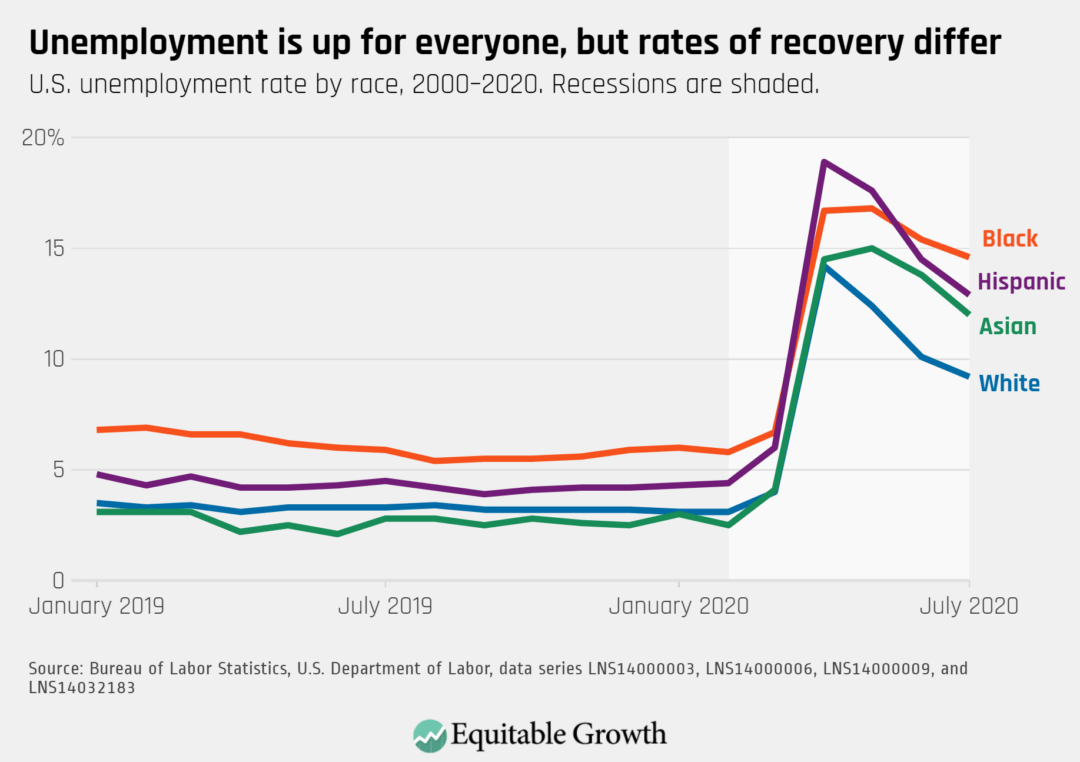Weekend reading: The July jobs report edition
This is a post we publish each Friday with links to articles that touch on economic inequality and growth. The first section is a round-up of what Equitable Growth published this week and the second is relevant and interesting articles we’re highlighting from elsewhere. We won’t be the first to share these articles, but we hope by taking a look back at the whole week, we can put them in context.
Equitable Growth round-up
The U.S. economy added 1.8 million jobs in July 2020, but the coronavirus recession is still wreaking havoc on the labor market, particularly for women and workers of color, whose unemployment rates remain above the overall level of 10.2 percent. Despite the gains, the prime-age employment to population ratio is still below 74 percent. And the July increase in jobs was well-below the 4.8 million increase in June, suggesting that the uptick in coronavirus cases that continued into July may be cooling a potential recovery. Kate Bahn and Carmen Sanchez Cumming put together a series of charts highlighting the most important trends in the data, as well as a column with further analysis of the release.
Before the jobs numbers were released today, Heather Boushey posted a series of tweets previewing the data and their implications for an eventual U.S. economic recovery from the coronavirus recession. It’s an insightful look into how these numbers can help guide policymakers’ next steps and how the novel coronavirus has affected practically every aspect of American life so far.
As policymakers continue to debate the next coronavirus relief stimulus bill and as cases of coronavirus and deaths from COVID-19 continue to rise across the United States, David Mitchell compiled a helpful round-up of 21 policy solutions that Equitable Growth has put forward to combat the impact of the coronavirus recession. The policies are grouped into several areas, from Unemployment Insurance to structural racism, and from child care to paid leave to climate change. Many of these policies are derived from our Vision 2020 project and featured on our dedicated coronavirus recession page, Mitchell notes, which is meant to guide policymakers in several areas during economic and policy conversations in 2020 and beyond.
Data analyzing the economic recovery after the Great Recession of 2007–2009 reveal that the economic growth that characterized the past decade (pre-coronavirus recession) was not shared equally across the United States. Not only did wealth and income divides widen further, but rural areas also saw less prosperity than urban areas, particularly in the Western region of the country. Raksha Kopparam breaks down the data, which looks at annual Gross Domestic Product growth by county and industry, finding that rural areas saw aggregate growth of around 14.8 percent, while urban areas registered growth of 19.2 percent during the post-Great Recession 11-year recovery. Kopparam dives into industry-specific trends over the years and why certain regions grew more than others, concluding with the implications for the coronavirus recession and eventual recovery.
Brad DeLong puts together his latest Worthy Reads, highlighting recent must-read content from Equitable Growth and around the web.
Links from around the web
The economic damage from the coronavirus recession is visible across the United States. And even though each new monthly jobs report since May has shown that the economy is adding jobs, unemployment is still ravaging local areas—some worse than others. The New York Times’ Quoctrung Bui and Emily Badger take a deeper look at the unemployment numbers in three American cities—New York, Los Angeles, and Chicago—to show that in some parts of these metropolitan areas, joblessness has reached astounding levels, around 30 percent in some cases. This means, Bui and Badger continue, that other problems, such as evictions, poverty, and hunger, are likely to follow close behind and will likely be geographically concentrated in areas that were already worse off before the crisis struck, with lasting consequences for the children growing up in these areas.
The coronavirus recession has affected women more than men, with 11.5 million women and 9 million men losing jobs between February and May. In fact, women’s job losses by the end of April wiped out a decade of gains. Amanda Holpuch of The Guardian examines how this recession differs from the Great Recession of 2007–2009, when men lost twice as many jobs as women, and attributes the difference mainly to the industries hardest hit by this downturn—those where women, especially women of color, hold a disproportionate number of jobs. Holpuch writes that these data highlight how women are more vulnerable to sudden losses of income due to the gender wage gap, as well as more dependent on child care and schools opening to be able to work.
Homeownership has long been considered one of the keys to wealth in the United States and an essential milestone on the path to achieving the American Dream. But Black Americans have been shut out of this process for decades—and the gap in homeownership rates between Black and White Americans is now wider than it was before the Civil Rights movement. The homeownership racial divide has especially important implications during the coronavirus recession, which has hit Americans of color harder than their White peers, as the wealth building that typically occurs alongside homeownership enables families to weather economic downturns and job losses. NBC News’ Nigel Chiwaya and Janell Ross explore the various ways homeownership and maintenance is kept out of reach and made more difficult for people of color in the United States, even for those who inherit already-paid-off homes from their parents and grandparents. They look at historical practices such as redlining and systemic barriers built into the financial system that have contributed to this trend, as well as the consequences that lack of homeownership have had and continue to have on Black communities.
Friday figure

Figure is from Equitable Growth’s “Equitable Growth’s Jobs Day Graphs: July 2020 Report Edition,” by Kate Bahn and Carmen Sanchez Cumming.
